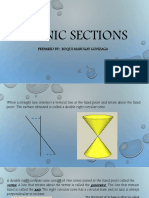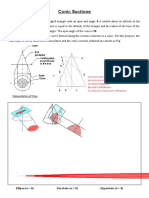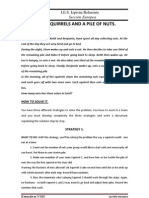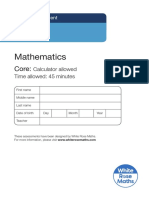I.E.S. Izpisúa Belmonte Sección Europea Locus - Conics. LOCUS (Lugar Geométrico)
I.E.S. Izpisúa Belmonte Sección Europea Locus - Conics. LOCUS (Lugar Geométrico)
Uploaded by
inmaillanCopyright:
Available Formats
I.E.S. Izpisúa Belmonte Sección Europea Locus - Conics. LOCUS (Lugar Geométrico)
I.E.S. Izpisúa Belmonte Sección Europea Locus - Conics. LOCUS (Lugar Geométrico)
Uploaded by
inmaillanOriginal Title
Copyright
Available Formats
Share this document
Did you find this document useful?
Is this content inappropriate?
Copyright:
Available Formats
I.E.S. Izpisúa Belmonte Sección Europea Locus - Conics. LOCUS (Lugar Geométrico)
I.E.S. Izpisúa Belmonte Sección Europea Locus - Conics. LOCUS (Lugar Geométrico)
Uploaded by
inmaillanCopyright:
Available Formats
I.E.S.
Izpisa Belmonte
Seccin Europea
Matemticas I Seccin Europea
65
LOCUS.CONICS.
LOCUS(Lugar geomtrico).
A locus is a set of points that satisfy a certain condition or criteria.
The criteria that defines the locus has to be translated to an algebraic
language in order to solve problems involving types of locus.
Perpendicular bisector: The perpendicular bisector of a line segment
is the locus of points on the plane that are equidistant from the endpoints.
Angle bisectors The bisector of an angle is the locus of points on the plane
that are equidistant from the rays that form the angle.
I.E.S. Izpisa Belmonte
Seccin Europea
Matemticas I Seccin Europea
66
CIRCLE.
Definition.
The equation of a circle is the locus of points on the plane that are
equidistant from a fixed point called the centre .This common distance is
called radius
Equation.
The equation of the circle whose centre is point O(a,b) and radius r is:
( ) ( )
2 2 2
r b y a x = + .
An equation of the type 0
2 2
= + + + + C By Ax y x can be a circle if
0
2 2
2 2
>
|
.
|
\
|
+
|
.
|
\
|
C
B A
, then its centre is point |
.
|
\
|
2
,
2
B A
and its radius is
C
B A
|
.
|
\
|
+
|
.
|
\
|
2 2
2 2
.
Circle passing through three non-aligned points.
Given three non-aligned points, there is a unique circle passing through
them. In order to determine its centre, we have to calculate the point of
intersection of the perpendicular bisector of the line segments determined for
the three points. The radius will be the distance from the centre to one of
these points.
I.E.S. Izpisa Belmonte
Seccin Europea
Matemticas I Seccin Europea
67
Circle-line intersection (Posiciones relativas de recta y
circunferencia).
To find the common points of a circle and a line, solve the systems
formed by the equations of both.
In general, a quadratic equation is obtained, which will have a sign for the
discriminant, , depending on the following solutions:
Secant Line
> 0 .
Two solutions: There are two points
of intersection.
Tangent line
= 0.
One solution: the line is a tangent to
the circle.
< 0.
No solution: There is no intersection
between the line and circle.
I.E.S. Izpisa Belmonte
Seccin Europea
Matemticas I Seccin Europea
68
ELIPSE.
Definition.
The ellipse is the locus of points on the plane whose sum of distances to two
fixed points, foci, are always constant.
Elements of the Ellipse
Foci
The foci are the fixed points of the ellipse which are located on the major axis. They are
denoted by F and F'.
Major Axis
The major axis of the ellipse is the line segment , which has a length of 2a.
Minor Axis
The minor axis of the ellipse is the line segment , which has a length of 2b.
Focal Length
The focal length of the ellipse is the line segment , which has a length of 2c.
Centre
The centre of the ellipse is the point of intersection of the axes. It is the centre of
symmetry of the ellipse.
Vertices
The vertices of the ellipse are the points of intersection of the ellipse with the axes. They
are denoted by A, A', B and B'.
Focal Radii
The focal radii are the line segments that join a point on the ellipse with both foci. They
are denoted by PF and PF'.
Semi-Major Axis
The semi-major axis is the line segment that runs from the centre of the ellipse, through a
focus, and to a vertex of the ellipse. Its length is a.
I.E.S. Izpisa Belmonte
Seccin Europea
Matemticas I Seccin Europea
69
Semi-Minor Axis
The semi-minor axis is the line segment, perpendicular to the semi-major axis, which
runs from the centre of the ellipse to a vertex. Its length is b.
If a = b, an ellipse is more accurately defined as a circle.
Axes of Symmetry
The axes of symmetry are the lines that coincide with the major and minor axes.
Relationship between the Semiaxes
Centre Major
axis
Graph Equation Foci
(0,0)
Horizontal
F'(-c, 0) and
F(c, 0)
(0,0)
Vertical
F'(0, -c) and
F(0, c)
(x
0,
y
0
)
Horizontal
F(x
0
-c,y
0
) and
F(x
0
+c,y
0
)
(x
0,
y
0
)
Vertical
F'(x
0
,y
0
c)
and F(x
0
,y+c)
I.E.S. Izpisa Belmonte
Seccin Europea
Matemticas I Seccin Europea
70
The eccentricity (excentricidad) of an ellipse is a number that expresses the
degree of roundness of the ellipse.
HYPERBOLA.
Definition.
The hyperbola is the locus of points on the plane whose difference of
distances to two fixed points, foci, are constant.
|d(P,F)-d(P,F)|=2a
Elements of the Hyperbola
Foci
The foci are the fixed points of the hyperbola. They are denoted by F and F'.
Transverse Axis or real axis
The transverse axis is the line segment between the foci. Conjugate Axis or
imaginary axis
The conjugate axis is the perpendicular bisector of the line segment
(transverse axis).
Centre
The centre is the point of intersection of the axes and is also the centre of
symmetry of the hyperbola.
Vertices
The points A and A' are the points of intersection of the hyperbola with the
transverse axis.
Focal Radii
The focal radii are the line segments that join a point on the hyperbola with
the foci: PF and PF'.
Focal Length
The focal length is the line segment , which has a length of 2c.
I.E.S. Izpisa Belmonte
Seccin Europea
Matemticas I Seccin Europea
71
Semi-Major Axis
The semi-major axis is the line segment that runs from the centre to a vertex
of the hyperbola. Its length is a.
Semi-Minor Axis
The semi-minor axis is a line segment which is perpendicular to the semi-
major axis. Its length is b.
Axes of Symmetry
The axes of symmetry are the lines that coincide with the transversal and
conjugate axis.
Asymptotes
The asymptotes are the lines with the equations:
The Relationship between the Semiaxes:
Eccentricity measures the degree of the opening of the branches of the
hyperbola.
I.E.S. Izpisa Belmonte
Seccin Europea
Matemticas I Seccin Europea
72
Centre,Real
axis
Graph Equation Foci
C(0,0)
Horizontal
F'(-c, 0) and
F(c, 0)
C(0,0)
Vertical
F'(0, -c) and
F(0, c)
(x
0,
y
0
)
Horizontal
F(x
0
-c,y
0
) and
F(x
0
+c,y
0
)
(x
0,
y
0
)
Vertical
F'(x
0
,y
0
c) and
F(x
0
,y+c)
PARABOLA.
Definition.
The parabola is the locus of points on the plane that is equidistant from
a fixed point called the focus and a fixed line called the directrix.
I.E.S. Izpisa Belmonte
Seccin Europea
Matemticas I Seccin Europea
73
Elements of the Parabola.
Focus
The focus is the fixed point F.
Directrix
The directrix is the fixed line d.
Focal Parameter
The focal parameter is the distance from the focus to the directrix. It is
denoted by p.
Axis
The axis is the line perpendicular to the directrix that passes through the
focus.
Vertex
The vertex is the point of intersection of the parabola with its axis.
Vertex, focus
and directrix
Axis Graph Equation
V(0,0)
F(p/2,0)
d:x=-p/2
x-axis
V(0,0)
F(-p/2,0)
d:x=p/2
x-axis
I.E.S. Izpisa Belmonte
Seccin Europea
Matemticas I Seccin Europea
74
V(a,b)
F(a+p/2,b)
d:x=a-p/2
Parallel to
x-axis
=2p(
V(0,0)
F(0,p/2)
d:y=-p/2
y-axis
V(0,0)
F(0,-p/2)
d:y=p/2
y-axis
V(a,b)
F((a, b+p/2)
d: y=b-p/2
Parallel to
y-axis
You might also like
- Practice Questions Trigonometry Class XDocument2 pagesPractice Questions Trigonometry Class XAnonymous La3xzbvxyW100% (8)
- Precalculus: Reference: TC7 by Leithold ©2015Document34 pagesPrecalculus: Reference: TC7 by Leithold ©2015Robert Tac-an NericuaNo ratings yet
- Lecture 3 Conic Section Part 2Document32 pagesLecture 3 Conic Section Part 2Jerwin OliverosNo ratings yet
- A Circle6Document6 pagesA Circle6Christian M. MortelNo ratings yet
- Parabola: John Martin FerrerDocument24 pagesParabola: John Martin FerrerHANNAH ANGELA GONo ratings yet
- Conic SectionDocument12 pagesConic Sectiondivyanshivikramsingh2007No ratings yet
- Fdocuments - in Conic Section PPT 55849eb7bffa4Document30 pagesFdocuments - in Conic Section PPT 55849eb7bffa4Ritesh RajNo ratings yet
- Conic Section: MATH-002 Dr. Farhana ShaheenDocument30 pagesConic Section: MATH-002 Dr. Farhana ShaheensivabathyNo ratings yet
- Conics Section SummaryDocument2 pagesConics Section SummaryRavi DesaiNo ratings yet
- MathDocument16 pagesMathPATRICIA NICOLE DIZONNo ratings yet
- Eccentricity LectureDocument16 pagesEccentricity LectureHanim GhazaliNo ratings yet
- Conic SectionDocument4 pagesConic Sectionhabibjamil55No ratings yet
- Pre Cal ReviewerDocument8 pagesPre Cal ReviewerstephencaongNo ratings yet
- 11 Maths Notes 11 Conic SectionsDocument3 pages11 Maths Notes 11 Conic SectionsamitNo ratings yet
- CH EllipseDocument27 pagesCH EllipseJoselito UbaldoNo ratings yet
- Introduction To Conic Sections and Circles (PT in Precal and Etech)Document8 pagesIntroduction To Conic Sections and Circles (PT in Precal and Etech)Stephanie TitularNo ratings yet
- EllipseDocument3 pagesEllipsesimran.sahooNo ratings yet
- CBSE Class 11 Mathematics Revision Notes Chapter-11 Conic SectionsDocument3 pagesCBSE Class 11 Mathematics Revision Notes Chapter-11 Conic SectionsmgfNo ratings yet
- ConicsDocument9 pagesConicsniranjankumar79No ratings yet
- Ellipse: Intercepts. The Endpoints of The Minor Axis Are (0, B) and (0, - B) and Are Referred To AsDocument18 pagesEllipse: Intercepts. The Endpoints of The Minor Axis Are (0, B) and (0, - B) and Are Referred To AseL LeahNo ratings yet
- Mathematics Monograph (EllipseDocument32 pagesMathematics Monograph (EllipseScribdTranslationsNo ratings yet
- Analytic GeometryDocument72 pagesAnalytic GeometryindaiNo ratings yet
- Ellipse (Definition, Equation, Properties, Eccentricity, Formulas)Document10 pagesEllipse (Definition, Equation, Properties, Eccentricity, Formulas)Anwar AftabNo ratings yet
- Ellipse 3Document23 pagesEllipse 3Rraffrizal ChandsNo ratings yet
- Pre Calculus EllipseDocument24 pagesPre Calculus EllipseKarl OliverosNo ratings yet
- (Rise Up) - Straight Lines - Sep 1Document238 pages(Rise Up) - Straight Lines - Sep 1prakhar100% (2)
- l5 Further Geometry2Document47 pagesl5 Further Geometry2Corrine ChanNo ratings yet
- DAY 1 - Distance Between Two PointsDocument18 pagesDAY 1 - Distance Between Two PointsShine ennaNo ratings yet
- Week 3 ModuleDocument25 pagesWeek 3 ModuleEdgar BachinichaNo ratings yet
- Conic SectionDocument58 pagesConic SectionNailah Sakinah100% (1)
- 02-Basic Classes of FunctionsDocument28 pages02-Basic Classes of FunctionsbryllelambonNo ratings yet
- Conic Section Maths Project PDFDocument13 pagesConic Section Maths Project PDFSiva Kumar75% (4)
- EllipseDocument29 pagesEllipseEdcademiaNo ratings yet
- Maths ProjectDocument31 pagesMaths ProjectKushagra VermaNo ratings yet
- Integral Calculus Analytic GeometryDocument8 pagesIntegral Calculus Analytic GeometryPerrie H.No ratings yet
- Terminologies in PRE CALCULUSDocument4 pagesTerminologies in PRE CALCULUSRehel AlegreNo ratings yet
- Module 4 Hyperbola 1Document17 pagesModule 4 Hyperbola 1Russel Cyrus SantiagoNo ratings yet
- Analytic Geometry MATH 004 (TIP Reviewer)Document9 pagesAnalytic Geometry MATH 004 (TIP Reviewer)James Lindo100% (1)
- Ellipse Hyperbola SynopsisDocument12 pagesEllipse Hyperbola SynopsisprekshithreddygattlaNo ratings yet
- Acute Angle DefinitionDocument5 pagesAcute Angle Definitionapi-126876773No ratings yet
- ELLIPSEDocument29 pagesELLIPSEgachaacc335No ratings yet
- Conic Sections Conic sections: θ2 = 90° (Only one nappe ofDocument10 pagesConic Sections Conic sections: θ2 = 90° (Only one nappe ofSteveMathewKuruvillaNo ratings yet
- HyperbolaDocument38 pagesHyperbolaMarineth Monsanto100% (2)
- Important Concepts and Formulae: Distance FormulaDocument6 pagesImportant Concepts and Formulae: Distance FormulaManokant PriharNo ratings yet
- 5 Point EllipseDocument13 pages5 Point EllipseTruong HuynhNo ratings yet
- HYPERBOLADocument3 pagesHYPERBOLAEmeron MantawidNo ratings yet
- Unit 5 Conic-SectionDocument23 pagesUnit 5 Conic-SectionBishesh ShresthaNo ratings yet
- Gradeup Short Notes On Ellipse and Hyperbola - pdf-82Document17 pagesGradeup Short Notes On Ellipse and Hyperbola - pdf-82Nitesh RajakNo ratings yet
- Conic Sections: Prepared By: Roqui Mabugay GonzagaDocument30 pagesConic Sections: Prepared By: Roqui Mabugay GonzagaRoqui M. GonzagaNo ratings yet
- Conic Sections: Nomenclature of ConeDocument13 pagesConic Sections: Nomenclature of ConeSai Radha KrishnaNo ratings yet
- 5 Parts of EllipseDocument16 pages5 Parts of EllipsechloecharmelferrarizNo ratings yet
- Analytical GeometryDocument14 pagesAnalytical GeometryGary GalvezNo ratings yet
- Conic SectionsDocument2 pagesConic SectionsAldrin PabloNo ratings yet
- Apollonius' Ellipse and Evolute Revisited: Frederick Hartmann and Robert JantzenDocument12 pagesApollonius' Ellipse and Evolute Revisited: Frederick Hartmann and Robert JantzenpkaranikNo ratings yet
- Co Ordinate GeometryDocument314 pagesCo Ordinate Geometryshubhammukri100% (1)
- Let Review 2019Document5 pagesLet Review 2019Sharen DivinagraciaNo ratings yet
- Reviewer Firstsem PrecalculusDocument9 pagesReviewer Firstsem PrecalculusChricellFNo ratings yet
- Conics SectionDocument34 pagesConics Sectionvanimittal06No ratings yet
- Investigatory Project Math ProjectDocument28 pagesInvestigatory Project Math ProjectYesh AgarwalNo ratings yet
- Statistical Project PULGADADocument3 pagesStatistical Project PULGADAinmaillanNo ratings yet
- 9 Elementary FunctionsDocument13 pages9 Elementary FunctionsinmaillanNo ratings yet
- Hoja 4 TrigonometriaDocument2 pagesHoja 4 TrigonometriainmaillanNo ratings yet
- Sección Europea: I.E.S. Izpisúa BelmonteDocument3 pagesSección Europea: I.E.S. Izpisúa BelmonteinmaillanNo ratings yet
- Three Squirrels and A Pile of NutsDocument4 pagesThree Squirrels and A Pile of NutsinmaillanNo ratings yet
- Soal Area Dan Perimeter SDDocument2 pagesSoal Area Dan Perimeter SDBeauconchaNo ratings yet
- Circles ArjunaDocument6 pagesCircles Arjunaajgangster3No ratings yet
- AF3Document2 pagesAF3hyacinth gulbenNo ratings yet
- Module 1 2nd Quarter d9Document4 pagesModule 1 2nd Quarter d9Abbie RañosaNo ratings yet
- Word Problems System of Linear Equation in Two VariablesDocument7 pagesWord Problems System of Linear Equation in Two VariablesJoric Magusara50% (4)
- A Linear Algorithm For Incremental Digital Display of Circular ArcsDocument7 pagesA Linear Algorithm For Incremental Digital Display of Circular Arcs•SANTRI SHARE•ITNo ratings yet
- BM Maths Written 2018 1 PDFDocument14 pagesBM Maths Written 2018 1 PDFgururajanNo ratings yet
- G13 1940 PUTNAM Web SolutionDocument15 pagesG13 1940 PUTNAM Web SolutionmokonoaniNo ratings yet
- June 2022 MSDocument33 pagesJune 2022 MSCharbel El habrNo ratings yet
- 1.system of Numbers and ConversionDocument20 pages1.system of Numbers and ConversionAmpolNo ratings yet
- Canadian Open Mathematics Challenge: The Canadian Mathematical SocietyDocument13 pagesCanadian Open Mathematics Challenge: The Canadian Mathematical Societyสฮาบูดีน สาและNo ratings yet
- Drilling Square HolesDocument5 pagesDrilling Square HolesAmgad AlsisiNo ratings yet
- Short Trick To Conquer Quantitative Aptitude..Document54 pagesShort Trick To Conquer Quantitative Aptitude..Chiranjeevi Kanike0% (1)
- Class 6 - Mathematics - 2017 - 18Document3 pagesClass 6 - Mathematics - 2017 - 18advait0807No ratings yet
- Std'10 - MathematicsDocument369 pagesStd'10 - MathematicsSanket Nikhade100% (1)
- Year 8 - Core - Spring 2020Document16 pagesYear 8 - Core - Spring 2020Hyun A JangNo ratings yet
- Math 21 Lec 2.6 Concavity and SDT (Slides)Document26 pagesMath 21 Lec 2.6 Concavity and SDT (Slides)Zyrille SilvaNo ratings yet
- Differentiation QuestionsDocument24 pagesDifferentiation QuestionsSudha BabuNo ratings yet
- Binary Subtraction: St. Paul University SurigaoDocument7 pagesBinary Subtraction: St. Paul University SurigaoKeziah AliwanagNo ratings yet
- E-Maxx Algo - Ru.enDocument614 pagesE-Maxx Algo - Ru.enadsfasfd123No ratings yet
- An Introduction To Parallel Programming Solutions, Chapter 1Document4 pagesAn Introduction To Parallel Programming Solutions, Chapter 1cheemashuja43No ratings yet
- 22mat - 11 Module 1&2Document2 pages22mat - 11 Module 1&2Prachi ChoudharyNo ratings yet
- Mathematics: Self-Learning Module 14Document14 pagesMathematics: Self-Learning Module 14Rachel PetersNo ratings yet
- Script of MathsDocument3 pagesScript of MathsSingh Classes100% (1)
- 1617 s4 Mat Whole (Eng) Fe (p2) QusDocument7 pages1617 s4 Mat Whole (Eng) Fe (p2) QusCHIU KEUNG OFFICIAL PRONo ratings yet
- LCM and HCFDocument25 pagesLCM and HCFManoj Swags7No ratings yet
- . Minimal Polynomials of 2 cos π n: A000010 A055034 A181875 A181876Document3 pages. Minimal Polynomials of 2 cos π n: A000010 A055034 A181875 A181876jgrisalesherNo ratings yet
- Math Unit 2 Grade 3 Lesson 51 53Document173 pagesMath Unit 2 Grade 3 Lesson 51 53Arlene SonNo ratings yet
- Fractions Convert To Decimal 001 PDFDocument2 pagesFractions Convert To Decimal 001 PDFEliane De Souza ZangNo ratings yet






























































































